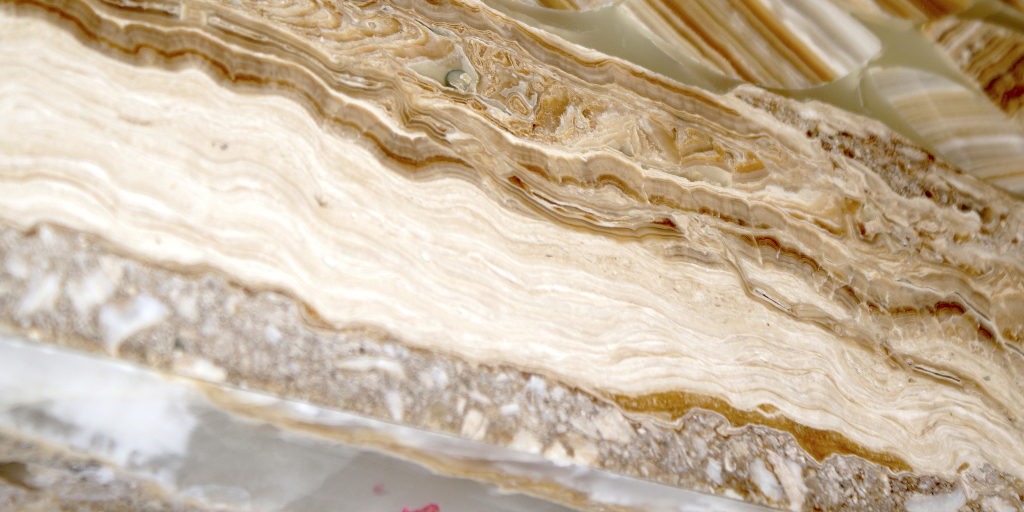About Natural Onyx
If you have researched the material called “onyx” you may have found that sometimes you get material that describes it as a natural material made of silica. However, you may also have found that there is other information that describes “onyx” as being a material made of calcite. Which of these is correct? The short answer is that both are true. In this post, we will begin by explaining briefly why there are two definitions and then we will talk about natural onyx in a particular context. So let’s get into the topic of natural onyx.
To Be Onyx With You, It’s All About Naming
Onyx is the name for a natural material. That statement in itself is 100% true. But what material does that name describe? That’s where it gets fuzzy. When talking about natural stone, geologists use one terminology and the commercial stone industry another. In several cases the same name is used to describe two different materials.
The geological name “onyx” is given to a natural material that is made up of silica. But the commercial term “onyx” is used to refer to a different natural material; one that is made up of calcite. In fact the material that is called onyx by the commercial stone industry is what geologists refer to as “banded calcite”. It is this “onyx” that we will be describing in this post – the one geologists call banded calcite.
Natural Properties of Onyx
Onyx is a peculiar material. As mentioned in the previous paragraph, it is a stone that is made up of calcite. That means that we are talking a material that is related to marble and natural limestone. In fact onyx is like marble in the sense that it too is a metamorphic rock. Being a calcareous stone like both marble and limestone are, onyx shares some properties with those materials.
The Hard Truth About Natural Onyx (Banded Calcite)
The onyx (banded calcite) is a relatively soft natural stone material. This is due to the fact that we just spoke of. Namely, that it is a calcareous stone. Stones that are composed of calcite live on the low end of the Mohs scale of mineral hardness. This scale is often used to measure the hardness of a stone. Onyx comes in it around 3-4 on that scale, which has a max of 10. So, although onyx is a stone, it is a “soft” one since many natural stone materials and even man made materials register up to 7 or even 8 on that scale.
Onyx’s Notable Natural Reaction
Another fundamental property of natural onyx is that it is sensitive to acid. Calcite, or calcium carbonate, reacts with acidic substances and neutralizes them. But in the process of neutralizing the acid, the calcite is dissolved. This means that surfaces made up of onyx should never be cleaned using an acidic cleaner. In fact, the best option for cleaning natural onyx is to us a cleaner specifically designed for cleaning natural stone.
Shining Light Through the Topic of Onyx
Perhaps one of the most remarkable traits of natural onyx is its translucency. Geologists call commercial onyx “banded calcite” because of its appearance. The stone has strips of translucent material alternating with opaque material. This characteristic of onyx makes it a fascinating material that is used in design projects wherein the onyx is backlit using LED lighting. The result is a focal point that literally lights up an area. Projects that make use of onyx include bars, canopy panels, cabinet inserts, step risers, and many other specific and creative uses.
About Natural Onyx Care and Maintenance
As we stated earlier, natural onyx is made up primarily of calcite. And, we also said that it reacts with acid. This means that it may not be the best option for a countertop surface (although it could be used for such) in a place where it will be exposed to such substances. Etching on onyx makes the surface look dull (if it is polished) or darkened (if it is honed). Caring for an etch on onyx can be done using an etch remover for natural stone.
“Poring” Over Onyx Density
Etching is not the only care treatment that is needed for onyx. It, like virtually all other natural stone, has pores. The density of onyx varies to one degree or another, but all of it is porous. That means it needs to be sealed to keep liquids that could be stain deliverers out of those pores. Therefore, sealing onyx with a natural onyx stone sealer is recommended. The frequency with which a stone needs to be treated depends on how absorbent it is at a given time. The absorbency may be tested using distilled water. The faster the stone takes in the water, the more it needs to be sealed.
That will wrap up our consideration of the material referred to as onyx in commercial stone terms. As we have discussed, it is a stone that has properties that potentially restricts its use for some applications. But has other properties that offer tremendous benefits for use in amazing applications.

